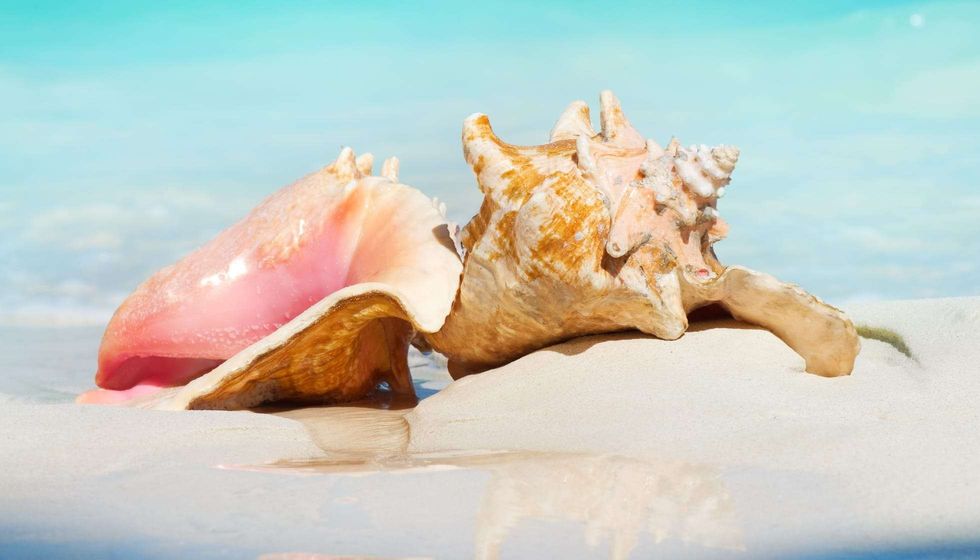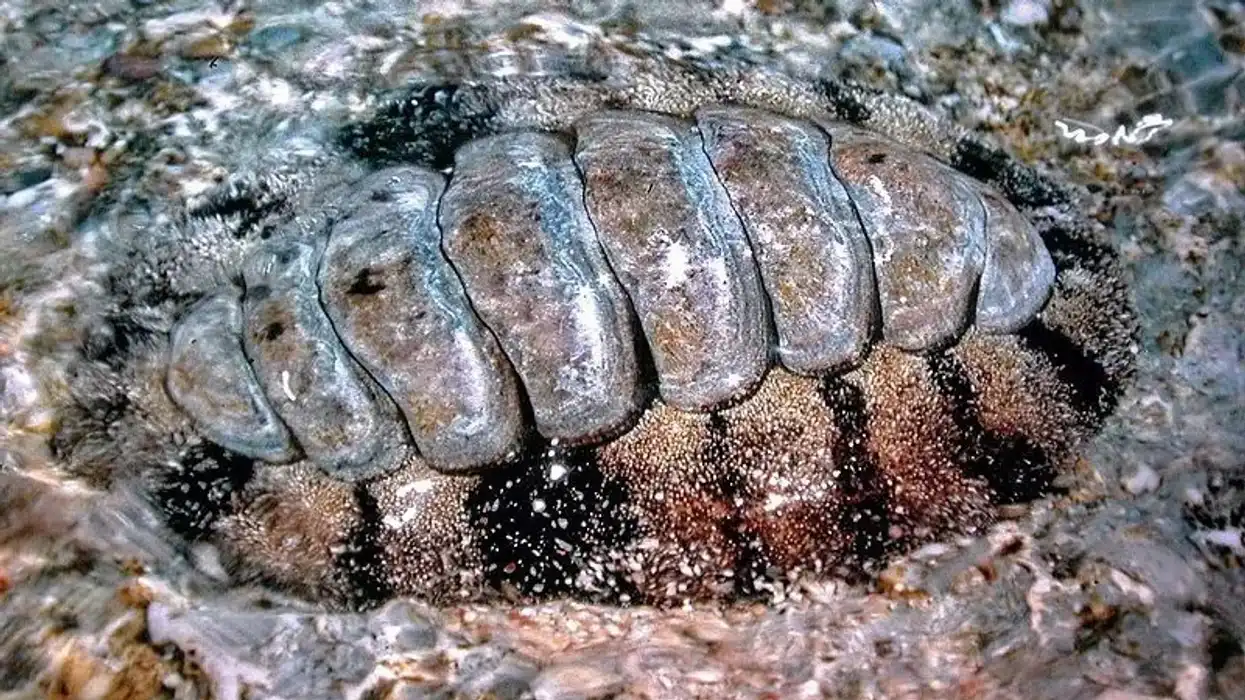With its unique anatomy, a Queen Conch looks like quite a fascinating animal. With a solid, thick beige/sandy-colored spiraled shell that comes with spikes on the shoulder, and a glossy pink or orange aperture, the Queen Conch (Strombus gigas) is a marine mollusk.
Until recently, it was also known as Lobatus gigas. In 2020, it was renamed, and today the Queen Conch's scientific name as per the World Register of Marine Species is Aliger gigas.
The exterior color of the shell is such that it helps it blend with the environment and saves the conchs from predators. Inside the conch shell is the soft body of the edible animal. The Queen Conch meat is consumed in the Caribbean countries as a delicacy.
An adult conch typically weighs around 5 lb (2.3 kg). The thicker the flare of the conch, the older it is. In this article, we share some fascinating facts about the Queen Conch, so do check them out.
We also have more exciting content on marine life on this website; if that is something that sounds exciting to you, then check out the article on cockles and crown-of-thorns starfish.
Queen Conch Interesting Facts
What type of animal is a queen conch?
The Queen Conch (Strombus gigas) belongs to the family of true conches and is a large gastropod mollusk. It falls in the same taxonomic group as squids, oysters, clams, and octopuses.
The mollusk has an average age of 30 years, and it reaches its maximum length of about 12 in (30.5 cm) in about five years. After that, it doesn't grow bigger as it ages, but the shell keeps on getting thicker.
What class of animal does a queen conch belong to?
A Queen Conch belongs to the class Gastropoda, order Littorinimorpha, and family Strombidae.
How many queen conchs are there in the world?
Since these conchs live on the ocean floor, it is impossible to estimate the world's Queen Conchs population accurately. But since this marine mollusk is a prized animal for both its shell and meat, it is overexploited through fishing in many coastal regions leading to a steep decline in its population.
Such a decline is seen as a threat to marine biodiversity and has led to many marine parks where fishing is controlled or prohibited.
Where does a queen conch live?
It is typically found in shallow tropical waters. It lives in the coral reef ecosystem and seagrass beds and sand flats. The conch species flourish in various types of habitats in the Caribbean coast, Florida Keys, South America, and the Gulf of Mexico.
What is a queen conch's habitat?
It lives in seagrass beds, sand flats, and the coral reef ecosystem. Depending on the depth of its habitat and the availability of aquatic vegetation, there are slight variations in its shell morphology, shape, length, and spike patterns.
Who do queen conchs live with?
Queen Conchs are primarily social animals. With its shell and soft body, the Lobatus gigas share a commensal relationship with many other animals.
Commensalism is a symbiotic biological relationship in which one species benefits while the other is neutral, i.e. neither benefitting nor being harmed. Animals like porcelain crabs, a type of cardinalfish called Conch fish, and Slipper snails are some animals that take shelter in the live queen conch's shell.
How long does a queen conch live?
The average life of a Queen Conch is about 20-30 years. Some living in protected marine parks and deep-sea waters are known to live as long as 40 years.
How do they reproduce?
Queen Conches are sexually mature at about three to four years of age when their lips are completely flared. Reproduction happens in Queen Conches through internal fertilization.
Massive egg spawning aggregations are formed by the Queen Conches during the breeding season, starting from March till October. The female lays about nine egg masses each season that are fertilized by multiple males, and each egg mass comprises about 180,000-460,000 eggs.
The eggs stick in gelatinous strands that can be 75 ft long and lie on sand beds.
The eggs are covered by sand grains, it acts as camouflage to save them from predators. After an incubation period of three to five days, the eggs hatch, and the larvae drift with the water currents and join the phytoplankton.
After 16-40 days of hatching from the eggs, they metamorph into tiny conches and live as benthic animals. As they grow, the shells grow harder and thicker, forming a protective layer over their soft bodies.
What is their conservation status?
The Queen Conch is not evaluated for its conservation status by the IUCN. While it is not endangered in the Caribbean Sea, its population is under threat in many areas due to overfishing for conch meat and shells.
CITES has listed it in Appendix II, which means that it is not an endangered species right now, but it could be if there are no proper trade controls put in place.
Queen Conch Fun Facts
What do queen conchs look like?
The Queen Conch's anatomy is similar to other snails. Inside the conch shell is a soft body that consists of its head, foot, and visceral body.
The body is characterized by a slender snout, long eyestalks with Queen Conch eyes, a tubular mouth called a proboscis, a crescent operculum, tentacles for a sense of smell and touch, and a tiny foot that helps it hop in the water.
When threatened, it can put its body inside the shell for safety from predators.
The shell of the adult animal is thick and heavy with a glossy pink or orange aperture and spines on the shoulder. The juvenile conches do not have a flared lip; it gets it at about four years of age when it gets sexually mature.
How cute are they?
The adult conches with well-developed shells look attractive. That's another reason why conch shells are a sought-after souvenir in the Caribbean.
How do they communicate?
There is not much data about how they communicate. It does have a pair of sensory tentacles that helps it get a touch of smell and touch and sense danger.
How big is a queen conch?
This species of conches is one of the largest mollusks. On average, they are about 6-13.9 in (15.2-35.2 cm) in length.
How fast can queen conchs move?
They are slow movers. They use their feet to lift the body and then use the operculum to hop forward in a hopping movement known as a strombid leap.
How much does a queen conch weigh?
They are among the biggest gastropods, and the adults typically weigh around 5 lb (2.3 kg).
What are the male and female names of the species?
There is no separate name for the males and the females of the species. They are referred to as male and female Queen Conch, respectively.
What would you call a baby queen conch?
There is no specific name to refer to a baby Queen Conch. The microscopic planktonic larvae of the species are known as veligers.
What do they eat?
They are herbivores and feed on macroalgae like red algae, green algae, decaying plant matter, and seagrass.
Are they harmful?
No, they are not harmful.
Would they make a good pet?
The Queen Conch snail is not domesticated by humans in any way and is not supposed to be kept as a pet. In many regions, holding a live Queen Conch is illegal and a punishable offense.
Did you know...
The species are highly susceptible to overfishing as they grow slowly and mate for reproduction only after about four years. A juvenile Queen Conch can easily be fished in shallow waters before it had a chance to reproduce.
Queen Conch's predators include nurse sharks, loggerhead turtles, stingrays, crustaceans, blue crabs, eagle rays, and spiny lobsters.
The species produce natural pearls in various hues like pink, light brown, and orange. The pearl is known as the Queen Conch pearl and is rare and popular for making jewelry.
What are queen conch shells made of?
Here is one of the interesting Queen Conch shell facts - the shell comprises 95% calcium carbonate. The species absorbs it from the seawater and utilizes it to form the shell structure. A glue-like protein binds the calcium carbonate in the shell in an intricately complex pattern of layers and sheets.
Where to find queen conch shells?
You can find Queen Conch shells on the Florida Keys beaches, beaches in northern South America, and the Caribbean, Bahamas, and Bermuda. Remember that collecting empty conch shells is fine, but taking shells with a live animal inside them is illegal and a punishable offense.
Here at Kidadl, we have carefully created lots of interesting family-friendly animal facts for everyone to discover! Learn more about some other arthropods including barnacles or hermit crabs.
You can even occupy yourself at home by drawing one on our queen conch coloring pages.










